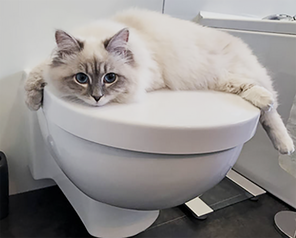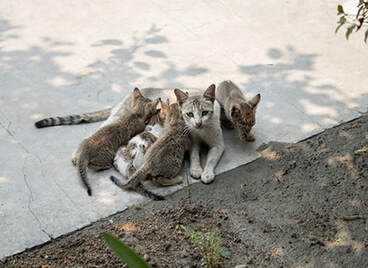
If YOUR favorite feline finds drinking from the toilet a paw-leasure, have you ever wondered why? And how to break her of this less than sanitary habit?
Cats don’t “consider” it a toilet. To them, it’s a giant water fountain in the bathroom! And so, drinking from this particular water supply seems purr-fectly reasonable.
Because toilets are typically made of porcelain, they work best at keeping the water cool – which felines, naturally, favor. While some cat water bowls may also be made of porcelain, the majority of them are made of stainless steel, plastic, glass or ceramic, materials that fail to keep the water as satisfyingly cool as porcelain does.
The toilet’s constant flushing causes water oxygenation, which helps freshen the water supply, making it more appealing for cats since it’s often fresher than the contents of their water bowls.
Constantly curious creatures, cats can be fascinated by watching water swirl down the drain. If they enjoy playing with or drinking water running from a sink faucet, they’ll likely be interested in playing with toilet water as well, which can, of course, lead to drinking it.
When cats drink water in a high traffic area, they often feel vulnerable and exposed. A toilet bowl affords them the privacy they prefer because they can keep their backs to the wall while enjoying a quiet drink.
Excessive water drinking (Polydipsia) may be a sign of several conditions, including diabetes, hyperthyroidism, an infection or kidney disease. Cats with polydipsia will drink from any source: the toilet, dripping faucets, the shower, drinking glasses and even puddles. If you suspect your cat is polydipsic, bring her to the vet who will likely run some blood and urine tests to determine the cause of her increased thirst.
Consider these ways to temper your cat’s passion for drinking from the toilet:
Purchase a porcelain water bowl, and refresh the water in it at least once a day. For warmer conditions, one or two ice cubes in the bowl can make a substantial difference.
Separate her water bowl from her food bowl by two to three feet and place them both in a quiet location where she can keep an eye on her surroundings, thereby reducing her sense of vulnerability.
Because most cats prefer to drink from several different sources of water, place multiple water bowls (six inches or smaller will do) in various areas throughout your home.
Since it’s vital to keep the water bowls clean, they should be washed thoroughly every day (twice a day would be even better), and then filled to the brim with fresh, cold water.
Knowing that cats are drawn to running water, particularly those who ONLY want to drink from running faucets, another possibility is a cat water fountain. Not only will the water be constantly circulating, allowing for oxygenation, a sturdy, quiet fountain that’s difficult to knock over is easier than keeping multiple bowls that require multiple cleanings throughout your home.
Last but not least: the simplest solution of all is to keep the toilet lid closed. In fact, it’s recommended that you ALWAYS close the lid before you flush. Research shows that putting the toilet lid down before flushing reduces airborne particles by 50%.










 RSS Feed
RSS Feed